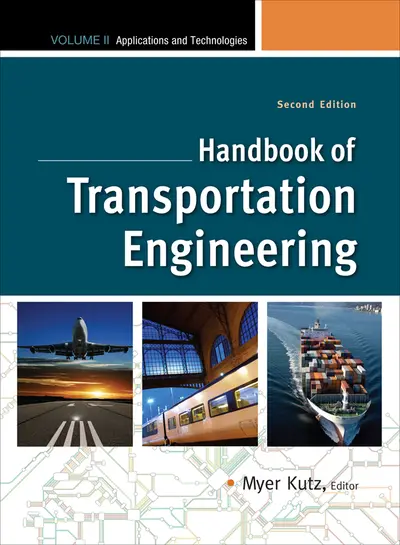My Account Details

ISBN10: 007161477X | ISBN13: 9780071614771

Step 1 . Download Adobe Digital Editions to your PC or Mac desktop/laptop.
Step 2. Register and authorize your Adobe ID (optional). To access your eBook on multiple devices, first create an Adobe ID at account.adobe.com. Then, open Adobe Digital Editions, go to the Help menu, and select "Authorize Computer" to link your Adobe ID.
Step 3. Open Your eBook. Use Adobe Digital Editions to open the file. If the eBook doesn’t open, contact customer service for assistance.
Publisher's Note: Products purchased from Third Party sellers are not guaranteed by the publisher for quality, authenticity, or access to any online entitlements included with the product. The definitive transportation engineering resource--fully revised and updated The two-volume Handbook of Transportation Engineering, Second Edition offers practical, comprehensive coverage of the entire transportation engineering field. Featuring 18 new chapters and contributions from nearly 70 leading experts, this authoritative work discusses all types of transportation systems--freight, passenger, air, rail, road, marine, and pipeline--and provides problem-solving engineering, planning, and design tools and techniques with examples of successful applications. Volume II focuses on applications in automobile and non-automobile transportation, and on safety and environmental issues. VOLUME II COVERS: Traffic engineering analysis Traffic origin-destination estimation Traffic congestion Highway capacity Traffic control systems: freeway management and communications Traffic signals Highway sign visibility Transportation lighting Geometric design of streets and highways Intersection and interchange design Pavement engineering: flexible and rigid pavements Pavement testing and evaluation Bridge engineering Tunnel engineering Pedestrians Bicycle transportation Spectrum of automated guideway transit (AGT) and its applications Railway vehicle engineering Railway track design Improvement of railroad yard operations Modern aircraft design techniques Airport design Air traffic control systems design Ship design Pipeline engineering Traffic safety Transportation hazards Hazardous materials transportation Incident management Network security and survivability Optimization of emergency evacuation plans Transportation noise issues Air quality issues in transportation Transportation and climate change
Preface
Vision Statement
Part III: Automobile Transportation--Traffic, Streets, and Highways
Chapter 1. Traffic Engineering Analysis
Chapter 2. Traffic Origin-Destination Estimation
Chapter 3. Traffic Congestion
Chapter 4. Highway Capacity
Chapter 5. Traffic Control Systems: Freeway Management and Communications
Chapter 6. Traffic Signals
Chapter 7. Highway Sign Visibility
Chapter 8. Roadway Transportation Lighting
Chapter 9. Geometric Design of Streets and Highways
Chapter 10. Intersection and Interchange Design
Chapter 11. Pavement Engineering I: Flexible Pavements
Chapter 12. Pavement Engineering II: Rigid Pavements
Chapter 13. Pavement Testing and Evaluation
Chapter 14. Modern Bridge Engineering
Chapter 15. Tunnel Engineering
Part IV: Non-Automobile Transportation
Chapter 16. Pedestrians
Chapter 17. Bicycle Transportation
Chapter 18. The Spectrum of Automated Guideway Transit (AGT) and its Applications
Chapter 19. Railway Vehicle Engineering
Chapter 20. Railway Track Design
Chapter 21. Improvement of Railroad Yard Operations
Chapter 22. Modern Aircraft Design Techniques
Chapter 23. Airport Design
Chapter 24. Air Traffic Control System Design
Chapter 25. Maritime Transport and Ship Design
Chapter 26. Oil and Gas Pipeline Engineering
Part V: Safety, Noise, and Air Quality
Chapter 27. Traffic Safety
Chapter 28. Transportation Hazards
Chapter 29. Hazardous Materials Transportation
Chapter 30. Incident Management
Chapter 31. Security and Survivability of Surface Transportation Networks
Chapter 32. Optimization of Emergency Evacuation Plans
Chapter 33. Transportation Noise Issues
Chapter 34. Transportation-Related Air Quality
Chapter 35. Climate Change and Transportation
Index
Need support? We're here to help - Get real-world support and resources every step of the way.